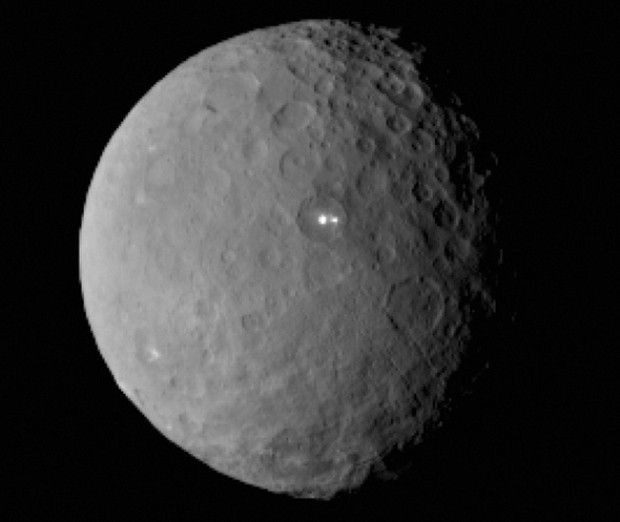About two weeks ago, on March 6, NASA's Dawn spacecraft came within 38,000 miles (about 61,000 kilometers) from Ceres, a dwarf planet orbiting the Sun between Mars and Jupiter, and was captured by its gravitational pull.
While on its way to Ceres, the probe studied and imaged its surface from afar. Some of the images it produced, one of which is available below, show a pair of mysterious spots shining bright inside an impact crater.
These two oddly bright spots, together with other less impressive ones, first became visible towards the end of January, when the Dawn spacecraft was about 147,000 miles (237,000 kilometers) away from dwarf planet Ceres.
As NASA's probe got closer and closer to its target, astronomers hoped that new and more detailed images would help them figure out what the spots were and how they appeared on the surface of Ceres.
A likely explanation
Since the bright spots are still visible even when close to Ceres' edge, scientists assume that they are produced by a geological structure rising high from the dwarf planet's surface and, therefore, unobstructed by the walls of its home impact crater.
“What is amazing is that you can see the feature while the rim is still in the line of sight,” explains Andreas Nathues, a planetary scientist working with the Max Planck Institute for Solar System Research in Göttingen, Germany, as cited by Nature.
Interestingly enough, the images thus far produced by NASA's Dawn probe show that the spots are at their brightest at dawn. Come dusk, they begin to fade. This indicates that their behavior depends on how much sunlight reaches Ceres at any given moment.
Based on what they have until now learned about them, scientists suspect that the mysterious bright spots on the surface of dwarf planet Ceres could be ice plumes, i.e. clouds of ice particles rising from the ground and reaching considerable heights.
These plumes might be the result of internal pressure pushing ice out of the celestial body. Then again, it is also possible that they are produced by sunlight reaching the dwarf planet's surface and causing part of the ice included in its anatomy to break apart and rise from the ground in the form of clouds.
Further research is needed
The scientific community became aware of Ceres' existence back in 1801, when the dwarf planet was discovered by an Italian astronomer by the name of Giuseppe Piazzi. Although it's been over two centuries since Ceres was identified, astronomers don't know all that much about it.
Investigations carried out over the years have shown that Ceres has a diameter of roughly 590 miles (950 kilometers), which makes it the largest object in the Solar System's asteroid belt. Its anatomy, however, is as big a mystery as the bright spots on its surface.
Some suspect that the celestial body packs a whole lot of ice, possibly as much as 25% of its overall mass. Others believe that it hosts seas and oceans, albeit not on its surface but in the underground. The Dawn probe is expected to help solve as least some of the mysteries surrounding Ceres.

 14 DAY TRIAL //
14 DAY TRIAL // 

